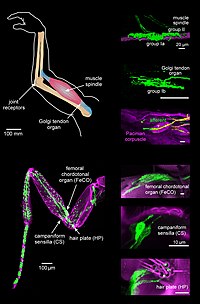
Photo from wikipedia
Sport-related injuries to articular structures often alter the sensory information conveyed by joint structures to the nervous system. However, the role of joint sensory afferents in motor control is still… Click to show full abstract
Sport-related injuries to articular structures often alter the sensory information conveyed by joint structures to the nervous system. However, the role of joint sensory afferents in motor control is still unclear. Here we evaluate the role of knee joint sensory afferents in the control of quadriceps muscles, hypothesizing that such sensory information modulates control strategies that limit patellofemoreal joint loading. We compared locomotor kinematics and muscle activity before and after inhibition of knee sensory afferents by injection of lidocaine into the knee capsule of rats. We evaluated whether this inhibition reduced the strength of correlation between the activity of vastus medialis (VM) and vastus lateralis (VL) both across strides and within each stride, coordination patterns that limit net mediolateral patellofemoral forces. We also evaluated whether this inhibition altered correlations amongst the other quadriceps muscles activity, the time-profiles of individual EMG envelopes, or movement kinematics. Neither the EMG envelopes nor limb kinematics were affected by the inhibition of knee sensory afferents. This perturbation also did not affect the correlations between VM and VL, suggesting that the regulation of patellofemoral joint loading is mediated by different mechanisms. However, inhibition of knee sensory afferents caused a significant reduction in the correlation between vastus intermedius (VI) and both VM and VL across, but not within, strides. Knee joint sensory afferents may therefore modulate the coordination between the vasti muscles but only at coarse time scales. Injuries compromising joint afferents might result in altered muscle coordination, potentially leading to persistent internal joint stresses and strains.
Journal Title: Journal of applied physiology
Year Published: 2023
Link to full text (if available)
Share on Social Media: Sign Up to like & get
recommendations!